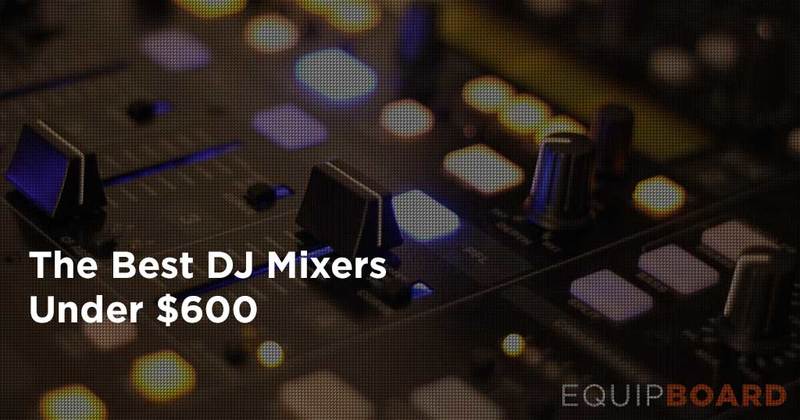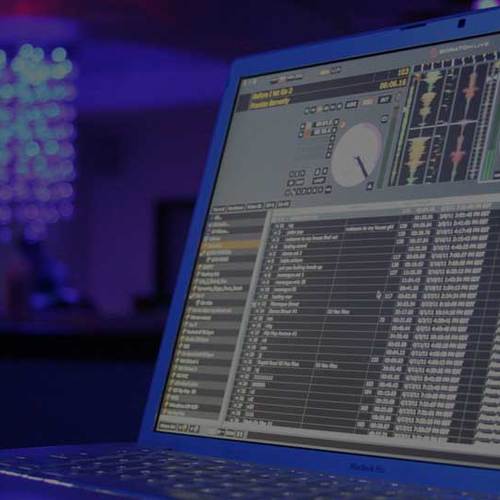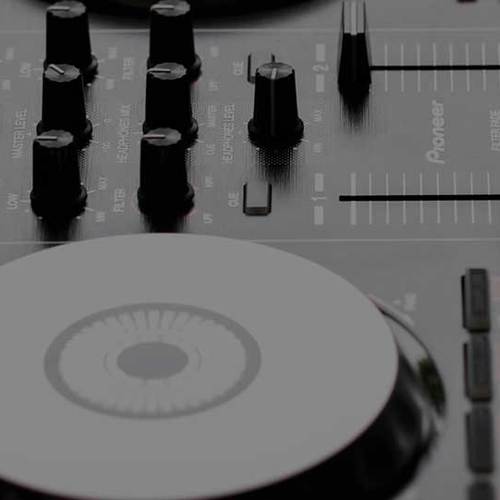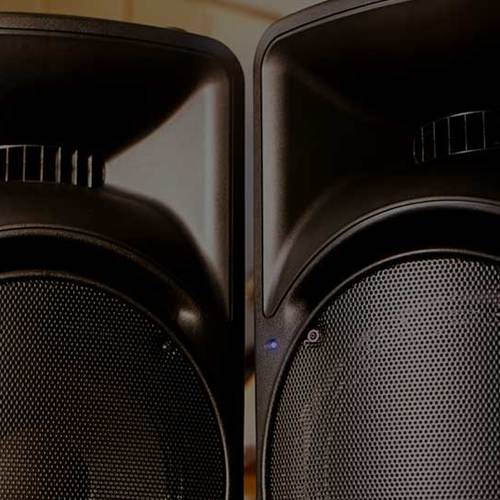The mixer is frequently thought of as the heart of a DJ setup. Think of it this way - if all you have is your turntables (or CD players or digital media players), all you’re able to do is press play, wait until a song ends, then press play on the next one, etc. That’s not so much DJing as much as it is just playing music. The DJ mixer is what allows you to perform; You can control the crowd by transitioning smoothly from one song to the next, make mashups by combining two or more audio signals, and keep things interesting with effects.
But, you probably already knew all this. If you’re reading this guide, there’s a good chance you know what DJ mixer is and does, and you want some recommendations for the best ones out there. We’ll talk about some of the things to consider when choosing a DJ mixer, and make 5 recommendations under the $600 price point.
Why You Need a DJ Mixer
In our guide to the best DJ controllers, we made an important distinction between a modular DJ setup, and an all-in-one DJ controller. Take a look at this diagram from that article:

In a modular DJ setup, like the one pictured on the left, you buy your music players (a.k.a. decks, CDJs, turntables) separately, and then plug their outputs into the inputs of a DJ mixer. The mixer combines these different audio signals and lets you control their volume levels and EQ settings individually. The output of the mixer then gets sent out to your sound system (and thus the DJ mixer has a master volume knob). In the case of an all-in-one DJ controller (pictured on the right), the two decks and mixer are all fused into one system. Typically, you use a controller like that to control DJ software running on your laptop (like Serato, TRAKTOR, or rekordbox dj).
Both the modular and all-in-one setup have their pros and cons. In this guide we’ll focus on the modular setup, since that’s the one that needs a DJ mixer. The advantage of a modular setup is that you can buy all the components separately, and you’re not necessarily tied to a single brand for the whole thing. You might want Pioneer decks, but an Allen & Heath mixer, for example. Since you can mix and match (no pun intended), you can also upgrade individual pieces when you’re able to. For instance, you can upgrade your DJ mixer from an entry-level to a pro-level one whenever budget allows. Furthermore, standalone DJ mixers tend to be higher quality than those integrated into all-in-one DJ controllers.
With a modular DJ setup you also don’t necessarily need a laptop running DJ software to perform. The setup can stand alone, playing music from vinyl records, CDs, or USB drives - whichever you prefer. DJing in the traditional way involves little more than two turntables, a 2-channel DJ mixer, headphones, and a crate of records - absolutely no computer required. Another type of DJ that can benefit from the modular setup is a turntablist that relies on scratching and beat juggling. In this case, the quality of the faders is particularly crucial, and some DJ mixers are built specifically with turntablists in mind (with a superior crossfader, for example).
What To Look For in a DJ Mixer
DJ Mixers are not simple - to the untrained eye most of them look like a spaceship control center with dozens of knobs, buttons, and sliders. Luckily, there are a few key things you should look for, to decide what the best DJ mixer is for you.
The most important thing to consider is how many channels you require. DJ mixers have at least 2 channels, meaning two different audio sources can be plugged in, and their audio signals mixed together. Every channel has a dedicated channel strip, where the audio source’s volume and EQ can be controlled (all mixers work this way, not just specifically DJ mixers). 4-channel mixers are also quite common, allowing you to plug in - you guessed it - 4 audio sources. Thing is, 2 channels is all you absolutely need as a DJ. As your skills progress maybe you’ll want to play with more than two turntables, or plug in additional toys like samplers, drum machines, etc. For this reason, it doesn’t hurt to invest in a mixer with more than 2 channels, even if 2 is all you’re using at the moment.

Aside from number of channels, several other things are important:
- Brand and quality: Unless you’re just building a DJ setup for practicing at home, chances are you’ll be gigging with your mixer. In the middle of a performance, few DJs have time to think about being extremely careful with their equipment - your mixer’s knobs and faders will take some abuse. Depending on how the venue is set up, your gear might get knocked around or even have a drink or two spilled on it. It’s important that whoever manufactures the mixer has experience making quality gear, and will stand behind it in case there’s a defect or something breaks prematurely.
- Effects and other features: Every DJ mixer has a few very basic components: channel strips (volume controls and EQ), a crossfader, a jack for your headphones, and outputs to hook the mixer up to your sound system. However, most DJ mixers throw in extra features, some of which will be useful to you, and some which will go unused. This includes effects, filters, USB connectivity, more complex I/O, integrated audio interface, and more. More features typically lead to a higher price tag.
- Budget: Budget is almost always the most important thing, as most musicians want the best gear they can afford that gets the job done. A bare-bones entry-level DJ mixer will have 2 channels, and very few (if any) bells and whistles. You’ll have to consider what you’re willing to sacrifice - will you be happy with a 2-channel mixer loaded with extra features? Or would you rather have a more stripped-down mixer with 4 channels?
- Special uses: Some DJ mixers are very straightforward, and are useful for any type of setup and style of DJing. Others are built for more specific purposes. The Native Instruments TRAKTOR KONTROL Z2, for example, will integrate tightly with TRAKTOR DJ software. The DJ Tech DIF-1S is particularly good for scratching.
Why You Should Trust Us
As you’re reading a guide like ours that makes product recommendations, you should always think about the source of the information. At Equipboard, we pride ourselves on bringing you some of the most thorough gear research around. For this guide, we spent days combining recommendations from several of our DJ contacts (many of whom have been DJing for decades), and DJs from various forums and groups. We combed through communities like reddit’s /r/DJs and DJ TechTools, and read through hundreds of user reviews from the likes of Amazon and Musician’s Friend. We then narrowed the list down, and tested the finalists ourselves to make sure the gear we’re recommending is truly worth your hard-earned cash.
Top 5 DJ Mixers
In this guide, we’re focusing on the 5 best DJ mixers currently available in the $150-600 range. We recommend both 2 and 4-channel mixers. Any of these 5 are perfect mixers to start out with, and should last you quite a bit of time before you feel the need to upgrade. All 5 would also make great backups in case your $2500 Pioneer DJM-2000NXS breaks.
Pioneer DJM-350

Number of Channels: 2
Standout Features: Easily record your mixes directly to a USB drive. Pioneer build quality and reliability.
When most DJs think of a DJ mixer, something like the Pioneer DJM-350 comes to mind. This is in part due to Pioneer’s status as industry standard DJ gear (9 out of 10 clubs have Pioneer gear in the DJ booth). Pioneer makes a lot of DJ mixers - from entry-level, to the stalwart DJM-900 found on stages everywhere, all the way up to the flagship DJM-2000NXS. Here we’ll be focusing on the entry-level end of the spectrum with the DJM-350 - having said that, calling the DJM-350 “entry-level” gives it far too little credit. While it does indeed make for a great entry-level DJ mixer (and is one of the lowest priced pieces of Pioneer gear), provided you don’t need more than 2 channels, it’s also a pro-level piece of equipment that has many of the same industry-standard features of higher-end Pioneer mixers that cost 2-4 times the price.
Pioneer’s DJM-350 is built extremely well. A big benefit of going with a Pioneer mixer is that it’s the marquee DJ brand, and Pioneer gear is relied upon by the biggest DJ superstars playing the biggest stages around the world. While the DJM-350 does not carry a premium price tag, it feels like a premium product. The fit and finish is pro level, and the unit looks attractive. While its footprint is compact, it’s sturdy and has a nice heft to it, weighing in at 7.05 lbs (3.2 kg).
The DJM-350 is a 2-channel DJ mixer, meaning you can plug two turntables/decks into it, and mix between the two sound sources. On the rear of the mixer you can see the inputs for both CH-1 and CH-2, and for each you can choose between PHONO (for a turntable), or CD (for a digital player like a CDJ), both of which are stereo RCA inputs. One of the great things about this mixer is that the controls are fairly uncomplicated and intuitive. In the middle you have your controls for channels 1 and 2, and your crossfader. For each channel you have a volume slider, 3-band EQ (LOW, MID, and HI), and a TRIM control. One really cool thing on this mixer is that the EQ bands are all “infinite kill,” meaning that when turned down all the way to the left, there is absolutely no sound in that frequency range. Between the channels you have LED level meters for both channels and master output, all of which are nice and bright and visible even in the harshest club or outdoor lighting. At the bottom you have your crossfader, which has a good feel - it’s nice and loose, making it well-suited for scratching (you can even select between two crossfader curve patterns, and you have FADER START capability for both channels). On the left of the mixer is a MIC/AUX section, which means that on the back of the mixer you can either plug in a microphone (via a ¼” input), or any other aux device (via stereo RCA jacks). This MIC/AUX channel has a 2-band EQ, and a LEVEL knob - it’s essentially like you have a “secret” third channel! Below this is a HEADPHONES section, where you can choose to queue up either channel in your headphones (the ¼” headphone output is conveniently placed on the front of the DJM-350).

Moving over to the right side of the mixer, in the lower half you have 4 built-in effects: GATE (which sort of chops up certain frequency bands), JET (a classic Pioneer flanging effect), CRUSH (a filter and bitcrusher), and FILTER. These effects sound really good, just like you would expect on Pioneer’s flagship units. The GATE effect sounds a little strange to us, and we’re not sure how useful it would be in a set - it’s a definite “your miles may vary” situation. Note that the effects cannot be applied per channel - it’s an all or nothing thing.
Finally, we get to one of the most interesting and useful parts of the Pioneer DJM-350: You can record your mix straight to a USB drive. Simply place a USB stick in the slot in the upper-right of the mixer, and press REC. There are so many good reasons to record your mix, and the DJM-350 makes it super easy without a need for a computer, extra cables, or any other gear. Once you have your set recorded, you can listen back and critique it so you can improve your skills. Your set will be saved as a high quality .wav file, so you can compress it any way you like and upload/distribute it on the Web. If you do a podcast or radio show, you can hit the TRACK MARK button to mark the start of a new track.
Bottom Line: Of the 5 mixers we recommend, the Pioneer DJM-350 is the priciest one (only a few dollars separate it from the Native Instruments TRAKTOR KONTROL Z2), bumping up against our $600 limit. So, is it worth the price of admission? We absolutely think so. If you want the same Pioneer mixer that all your favorite pros are using in the club, you’ll have to shell out about $2000. The DJM-350 is basically just a stripped down version for ¼ the price, but it still retains the Pioneer feel, build quality, and sound quality. Is it perfect? No; We wish the MASTER OUT was balanced XLR, as opposed to unbalanced RCA. Also it would be great if you had the ability to control the effects per channel. All things considered, these are minor sacrifices for a mixer in this price range. Whether you’re using the DJM-350 with CDJs or turntables, it’s a rock-solid 2-channel DJ mixer that will get you from the bedroom to the club. The ability to easily record your set to a USB drive is perfect for sharing your music, practicing, or podcasting.
Allen & Heath Xone:23

Number of Channels: 2
Standout Features: Superior sound quality. Excellent filter.
Allen & Heath and Pioneer are sworn enemies in the DJ gear camp. While Pioneer takes the crown in terms of popularity, Allen & Heath wins when it comes to sound quality. One of the most interesting and well-reviewed intro-level DJ mixers out there is the Allen & Heath Xone:23 2-channel mixer (FYI Xone is pronounced like “zone”). For such a quality piece of gear it’s astoundingly affordable, coming in a couple hundred dollars less than the Pioneer DJM-350. We’ll be comparing these two mixers throughout this review, since they’re both vying for your heard-earned money for a solid, well performing 2-channel DJ mixer.
Allen & Heath has a long history of producing extremely quality gear, and the Xone:23 is no exception. The unit looks and feels very polished, and at 6 lbs (2.71 kg) it’s quite sturdy on a tabletop. Two channels means two sound sources can be plugged in and mixed together. Like the DJM-350, on the back of the Xone:23 there are two sets of inputs for each of the two channels, PHONO (for record decks) and LINE. Also on the back is an FX LOOP (send and return), so you can patch in an external effects unit like a Pioneer RMX-1000. There’s an EXT-ON button on that switches the effects loop on/off, but unfortunately just like the effects onboard the Pioneer DJM-350, you cannot apply it per channel - either your entire signal has effects applied to it, or nothing. The output options are superior to those of the DJM-350. You have balanced XLR MASTER outputs, MONITOR output (a.k.a. booth), and RECORD output for sending your mix signal somewhere else to be recorded.
Similar to the DJM-350, the Xone:23 has a fairly simple, traditional layout that won’t take very long to figure out. It’s not without its quirks, however. Unlike most other DJ mixers, the Xone:23 eschews a toggle switch to select between PHONO and LINE level on top of each channel. Instead, atop each channel strip are two trim knobs to separately control the volume of whatever you have plugged into LINE, and PHONO. In a way, that makes the Xone:23 a 4-channel mixer... although not exactly (Allen & Heath calls it a “2+2” configuration). The 3-band EQ, FILTER and CUE on a channel will apply to both signals simultaneously, so it’s not really a true 4-channel mixer with 4 independent channels. From our research it would seem most DJs prefer the traditional toggle switch.

Some other interesting features are a “full kill” EQ for each of the 3 bands, an XLR MIC channel for plugging in a mic or an aux device (with its own level and 2-band EQ), and a very interesting filter section. The Xone:23 doesn’t have built-in effects like on the Pioneer DJM-350, but you do get a filter, and a great one at that (one of Allen & Heath’s biggest selling points is the quality of their filters). That said, the filter is configured a little bit strangely. Each channel has a FILTER button which determines if the filter should be applied to that channel, but the actual filter controls are in the middle of the mixer. Allen & Heath put some extra love into designing this filter, as it has settings for high-pass and low-pass, as well as a RESONANCE control.
Moving to the bottom of the mixer you’ve got a crossfader, which we’re lukewarm on. It’s neither very good nor very bad; not exactly up to a scratch mixer standard, but it’ll do fine for most other uses (there’s a 2-way toggle to select fader curve - hard cut or gradual). Note that you can replace it with an Xone Innofader for a superior scratch experience (look for part number 004-504JIT).
Bottom Line: In terms of sound quality there’s just something special about Allen & Heath. Perhaps to the casual users all DJ mixers more or less sound the same, but the audiophile will notice that Allen & Heath is just a cut above the rest in terms of sheer sound quality, and that’s definitely the case with the Xone:23. It doesn’t have the ability to record direct to USB like the DJM-350, but it makes up for it by having flexible I/O and a balanced master out. The crossfader isn’t good for scratching, though it can be replaced. Also, the LED meter only shows the master, not the individual channels (this appears to be a deal-breaker for some DJs). One of the biggest things this DJ mixer has over its Pioneer rival is a much lower price tag; it’s surprising a mixer of this quality is this affordably priced. If you can live with the drawbacks we mentioned, this would make a perfect versatile and reliable 2-channel DJ mixer for both practice and gigs.
Check Price on Amazon
Native Instruments TRAKTOR KONTROL Z2

Number of Channels: 2
Standout Features: Swiss Army Knife of a mixer that accommodates vinyl, CDJs, and is brilliant for digital DJs using TRAKTOR.
The Native Instruments TRAKTOR KONTROL Z2 mixer is one of the most highly recommended DJ mixers around, and one of the most versatile. It gives you all of the benefits of a modern controller packed into a 10 inch battle mixer. It’s surprising that more DJs don’t use the Z2 for DMC and Thre3style DJ championships. The TRAKTOR KONTROL Z2 is the perfect blend of digital and old school analog technology while delivering almost everything a DJ could ask for from TRAKTOR DJ software in regards to mixing. The only portion of TRAKTOR that isn’t fully utilized with the standard MIDI map is the Remix Decks functionality, but Remix Decks are not what the Z2 is best suited for (there are several Native Instruments controllers you can add to your setup to get the most out of the Remix Decks while using the Z2 as your main hub).
As far as specs go, the Z2 has everything a DJ could want out of a battle mixer, and a lot more. You have all your basic 2-channel functionality such as EQ, high/low pass filter, phono/line options, mic input with effects, volume control, channel fader, master and booth outputs, headphone cue with volume control, as well as TRAKTOR specific function buttons such as shift, cue points, mini-scroll wheel, macro-FX with pre and post capabilities, deck load buttons, sync buttons, and loop. The Z2 has both XLR and RCA main outputs with ¼” booth output for a monitor. You also have two extra USB inputs for external hard drives. On top of all that, this mixer is built like a tank with a solid metal chassis.

Now, let’s get down to why the Z2 can keep up with mixers double or triple its price. Besides the aforementioned durability, the Z2 has a trick up its sleeve which makes it stand above most other mixers. Did your old school friend come to throw down with a bag of vinyl? Not a problem. Just press the TRAKTOR button directly next to phono/line toggle switch on either channel and the Z2 now functions just like an old school battle mixer. When using this mode the FX do not work but you still have full volume and fader control, full EQ with either channel and the filter still works too. Being able to seamlessly switch between analog and digital at the literal push of a button makes the Z2 a battle DJ’s dream mixer.
Sound quality from the built in Traktor sound card is top-notch. Even in thru-mode with regular vinyl, sound quality is still very crisp (although a lot of that is directly influenced by your needles). If you aspire to win the DMC’s or become a Thre3style champ and prefer TRAKTOR the Z2 is what you want in your life. You can adjust the fader’s sharpness which is crucial for getting clean cuts. You even get a hamster switch (reverse) for the crossfader. Basic mixing using control vinyl or CDJs is a breeze with the Z2. We’re in the habit of looping to make sure we’re on beat which is very easy with the Z2. You can pull off some pretty out of this world routines with the Z2 once you implement cue points for each channel. The 4 buttons on either side actually turn into 8 for each channel once you use the SHIFT key. If you wanted to you could run 2 vinyl decks and 2 CDJ decks taking advantage of both phono and line inputs on each channel. The drawback with that setup is being able to remember where everything like EQ/volume etc. is on each channel as you flip between them all but it can be done with practice (an easy way to avoid any major screw ups is to make sure you have soft-takeover on for everything with the controller editor). You can also do some really cool stuff with the macro-FX using the pre and post options. That means you can set an echo while you scratch and when the fader is off it will still echo as a basic example. That brings us to one of the few drawbacks of the Z2, which is not getting the full range FX that TRAKTOR offers, since you are only able to use macro-FX. On the plus side though no matter which channel you have a macro-effect set you have the option to turn it on for either channel.
Bottom Line: There’s no other mixer with a built-in sound card for digital DJing in this price range that can compete with what you get in the TRAKTOR KONTROL Z2. If you are looking for the ability to become proficient in the art of turntablism in the digital age we would dare say there is almost no better option on the market today (it’s not exactly cheap, but keep in mind included with this mixer is the full version of TRAKTOR SCRATCH PRO 2 software). As we mentioned earlier, if you are looking to get into live remixing with Remix Decks and stems, Native Instruments has better options with other controllers. But if you are looking for the ability to show up to a gig and put on the kind of show people think of when they hear the word DJ then this is the mixer is a great choice. Quite simply, the Z2 excels because it accommodates every type of DJ - vinyl, CDJs, and especially digital DJs using TRAKTOR - all while having a build quality worthy of battle DJing. No matter your skill level, the Z2 comes highly recommended.
If you’re still not convinced, have a look at DJ Craze show off a little bit of what can be achieved with the Z2:
Check Price on Amazon
Numark M6 USB

Number of Channels: 4
Standout Features: Can be used as a USB audio interface.
Let’s get right down to business - it’s near impossible to get a reliable, quality 4-channel mixer for cheaper than you can get the Numark M6 USB. If you read the intro to this guide, you’ll recall we said that for a budget mixer, you can either get fewer channels and more features, or vice versa. Well in this case, you get more channels (4 of them), and the biggest feature you’re giving up versus other mixers is built-in effects. Luckily effects aren’t crucial to the art of DJing (except for maybe a filter, but at this price you just can’t have it all), but to compensate you get USB functionality. Let’s dig into the finer points (and foibles) of this very impressive, beginner-friendly DJ mixer.
Numark is a big player when it comes to DJ gear, so it’s no surprise the M6 is well-built. While it may carry a very budget-friendly price tag, if we didn’t know we would not guess this was a budget mixer. It looks great and feels rugged, like it could take some abuse in a club environment. It’s also surprisingly light for a 4-channel mixer, coming in at 9.6 lbs (4.35 kg). In terms of features, the Numark M6 is as straightforward as it gets. Each of the 4 channels has a channel strip with volume fader, a rather small CUE button (a bit too small actually), 3-band EQ (-30dB), 4-segment LED meter, a GAIN knob, and a toggle switch to select the input source. The input sources are interesting, but we’ll get back to that shortly. You have a dedicated MIC INPUT channel on the left of the mixer, with its own GAIN and 3-band EQ. There’s basic headphone cueing, and the ¼” headphone jack is on top of the mixer, in the lower-left corner. Like most DJ mixers, to the right you’ll find the more global controls like MASTER volume fader, BOOTH level, and MASTER LED meter. The crossfader is decent, with two selectable curve settings. Scratch DJs will want to replace the crossfader (luckily it’s designed to be removed and replaced).
The inputs and outputs are where this mixer shines, and punches above its weight class considering how inexpensive it is. For channels 1 and 2, you can select between PHONO and LINE RCA inputs (use phono for a vinyl turntable). Channel 3 has a LINE input, but can also receive audio via USB. This means that you can take audio from a Mac or PC and mix it into the 3rd channel of the Numark M6. Channel 4 has a LINE input as well, and an additional ¼” mic input. The left & right MASTER outputs are balanced XLR, which is a professional touch that similarly priced mixers usually don’t have. The M6 also sports RCA MASTER outputs, RCA BOOTH outputs, and RCA RECORD outputs. Another benefit of the USB connection is that this DJ mixer doubles as an audio interface. In other words, simply plug in the USB cable into your PC or Mac, and you’ll easily be able to record whatever instruments you have plugged into the mixer into your DAW of choice. This is also a very easy and convenient way to record your DJ set.

Where the Numark M6 USB mixer is lacking is effects. To keep the cost down, no effects such as a filter or flanger has been included. If you’re just starting out with DJing, have an external effects unit, or are simply using the M6 as an interface, this might not bother you. As your DJ skills advance you might miss the ability to make interesting transitions and built tension using effects.
Bottom Line: The Numark M6 USB is a perfect example of a no-frills mixer that manages to keep the price tag low, while at the same time not skimping on important features. Whether you consider a lack of effects a deal-breaker or not depends on your experience and skill level, as well as what other gear you use. The M6 is a perfect DJ mixer to start out with as you’re building out your setup, and learning the craft of DJing. Having USB is a big plus, since you can use it as part of a digital DJ setup that interfaces with your computer - but of course you’re welcome to ignore USB and just do a more traditional setup with turntables or CDJs. Either way, the Numark M6 wins the award for Best Bang for your Buck.
Check Price on Amazon
Behringer DDM4000

Number of Channels: 4
Standout Features: Matches industry standard DJ mixers in terms of features for a fraction of the cost.
With a wide array of formats, features, and brand names, to choose from selecting your first DJ mixer can be a daunting task for beginning DJs. In lieu of shelling out thousands of dollars for the top-of-the-line club standard mixers, most beginning DJs are looking for a product that offers features similar to the flagship models at a more accessible price point. Enter the Behringer DDM4000.
The DDM4000 is not a no-frills clean and simple mixer. In fact the first thing you will notice is that it has as more buttons and knobs than a fighter jet. This is because the DDM4000 strives to do what so few mixers have managed - give you all the features of a top tier mixer with the price tag of an entry level one. Among the numerous features in the DDM4000 are: 4 channels, sample record and playback, individual fader curve adjust, loads of LED backlit lights (great for visibility), MIDI in/out, and an extensive bank of sound FX.

So with all of these features where do the savings come from? The first part is in the build quality. While it’s by no means a flimsy device the DDM4000 does lack the sturdy build of higher end mixers. The knobs are plastic instead of rubber, the faders’ movement feels a bit off, and the FX screen is last generation. Not that the DDM4000 is going to fall apart on you any time soon; it isn’t a poorly constructed mixer. It just lacks the premium feel of a higher priced product like Pioneer’s DJM-900NX2. Really though as an entry-level mixer it is supposed to feel this way and beginning users will not care that it doesn’t feel like the industry standard, because it still performs like it.
Next comes the sound quality. This is the second area where Behringer decided to save some money. The sound quality can best be described as good, not great. No extra electric hum or other noises are added, but it lacks a pristine, crisp sound of the best mixers. So will this mixer ever rock the massive sound system at the Ultra Music Festival? Probably not, but anyone performing at large festivals won’t be using it anyways. Most people will be using it as a first mixer playing at home or small parties, and there it will work like a charm. Even mobile DJ speakers (such as the QSC K Series) will not betray the mixer. The sound difference will really only become noticeable when you step up to really large scale sound systems and at that point you will likely have moved on to a more “pro level” mixer anyways.
When it comes to actually using the mixer with all of its features, the DDM4000 can appear a bit overwhelming at first. However, an intuitive layout and simple control scheme means that it can be figured out in a fairly short amount of time. The FX section is probably the most daunting aspect with a lot of information thrown at you at once. Basic features such as EQ and crossfading work exactly as you would expect and these fundamentals will carry over to any mixer you will ever use. Of course the DDM is able to work alongside media such as CDJs, turntables, or really any device with an RCA output. Its MIDI in/out also means that it can function as a controller for digital DJ programs.
The great thing about the DDM is that even if you eventually move on to something like a $2000 Pioneer DJ mixer, its usefulness doesn’t run out! So long as you’ve treated it well you will still have a great functioning mixer on hand and it is the perfect backup mixer. For a full size 4-channel mixer it is surprisingly light weight (9.3 lbs) so as not to add a ton of weight to your setup. Unlike more stripped-down mixers, the DDM4000’s feature set means that the creativity of your set will not be hampered should your main mixer fail. Simply switch in the DDM and keep on going with whatever tricks you want, because chances are the DDM can do it.
Bottom Line: Overall then the Behringer DDM4000 is a fantastic choice for anyone looking to enter the world of DJing with more than just two decks and a crossfader. Priced competitively with all the features you could ever want an more, the DDM4000 will make an excellent first mixer for the beginning DJ and retains its usefulness as a fully featured backup for veterans. You won’t be bringing this mixer to your headline festival set, but it can teach you what you need to learn to get there.
Check Price on Amazon














